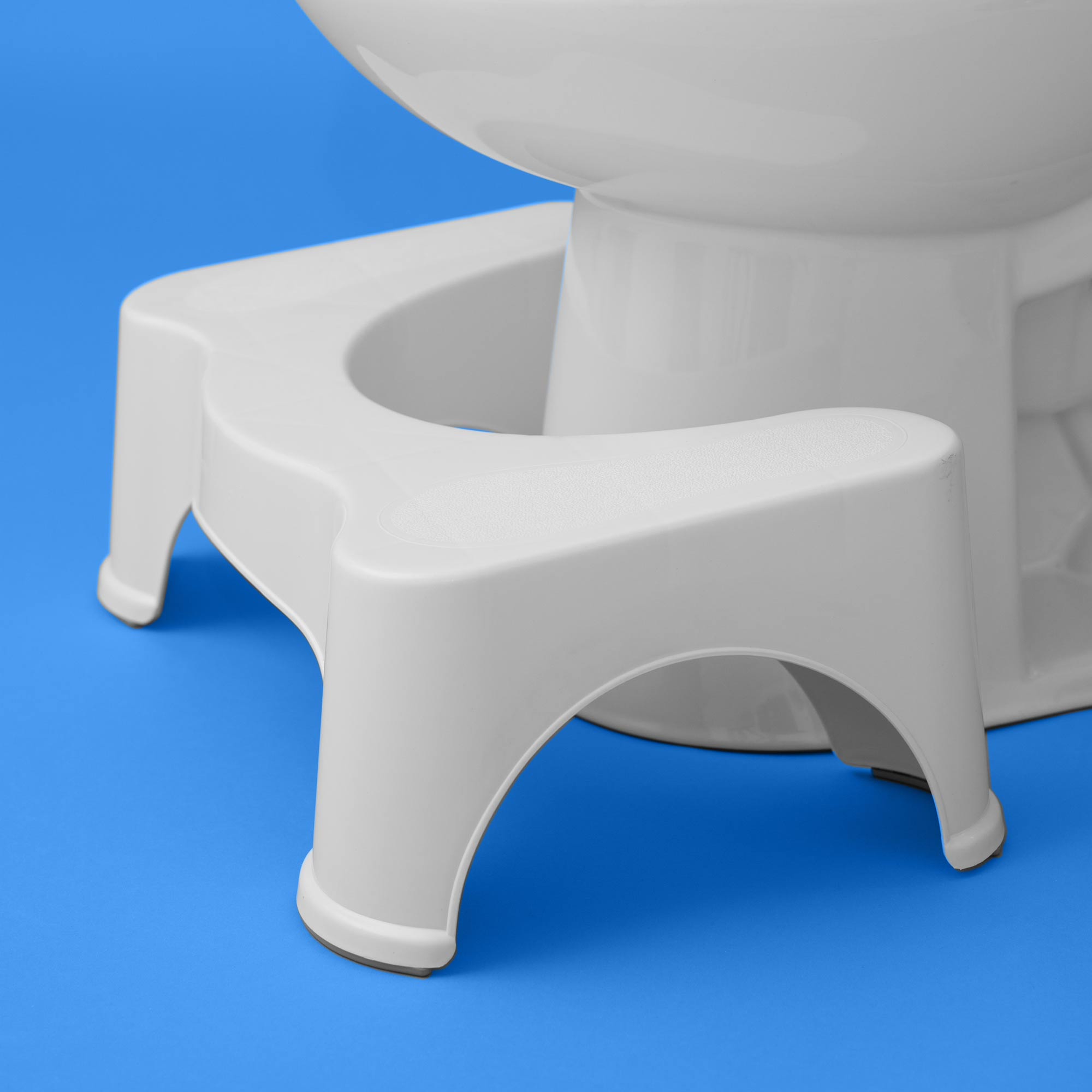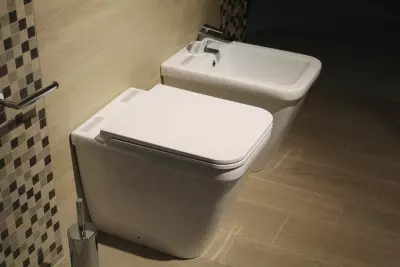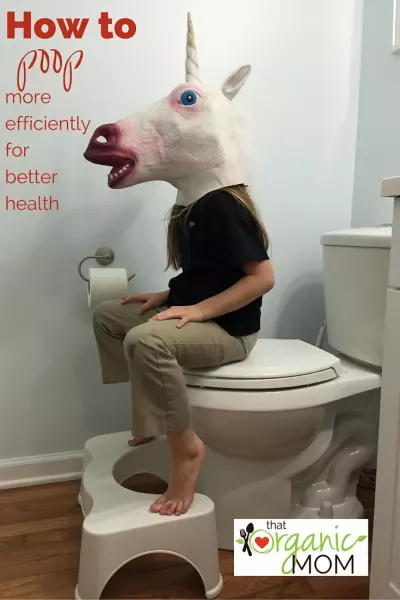Last Updated on October 24, 2022 by Rebecca Huff
These four tips will improve bathroom habits which will result in better health for you and the environment. Stick with me.
Overall, as a society, we are very reluctant to discuss bathroom issues and even more reluctant to change hygiene habits even though some of their current habits are outdated. I understand that talking about your bathroom habits can be a little uncomfortable. Still, this is a habit you need to get right!
Walking, drinking water, prebiotics, and probiotics, enough fiber from veggies, getting more magnesium, and even stress management can help you have more successful and regular bowel movements.
Table of Contents[Hide][Show]
1 – A Toilet Stool To Help You Squat
If you use a stool to poop, you can count on better health. Before you get grossed out and dismiss this concept, let me prove this habit can make a difference in your overall health and wellness.
A footstool can greatly improve your ability to eliminate fully and without strain.
When I started studying ways to achieve better health, someone suggested using a “stool for your stool,” That tip has stuck with our family.
At first, we used a stool already in our bathrooms for the children to reach the sink, which worked pretty well but wasn’t quite high enough or wide enough to fit properly at the toilet. Then later, we bought a stool specifically made for use at the toilet, pictured below made by Squatty Potty. Recently (2020) I upgraded all my stools to Squatty Potty’s bamboo version.
Squatting may help prevent hemorrhoids or prevent the worsening of hemorrhoids. The squat posture is also better for pregnant women as squatting avoids putting pressure on the uterus. One study suggests that the greater the hip flexion achieved by squatting, the straighter the rectoanal canal will be; accordingly, less strain will be required for defecation. (source)
While any footstool could help, the height and slant of Squatty potty, along with the space designed specifically for feet makes it much more useful.
2 – Eliminate Constipation With A Stool
The squatting position may be all it takes to relieve chronic constipation. Scientists explain defecation postural modification devices or DPMDs (stools such as the squatty potty) help you go more easily and avoid constipation.
The results of the [one] study suggest that the greater the hip flexion achieved by squatting, the straighter the rectoanal canal will be, and accordingly, less strain will be required for defecation. 1
pubmed
Another study showed that the stool positively influenced bowel movement duration, straining patterns, and complete evacuation of bowels. 2
For those with IBS and other health conditions of the intestine, a stool can be life-changing. Straining, constipation, bloating, hemorrhoids and fissures can be a nightmare. I’ve read positive reviews of the Squatty Potty from people with anal fissures or hemorrhoids. Using a stool is much less invasive or harsh than laxatives or drinking high-fiber supplements.
Squatty Potty works, and your digestive system will thank you for the help. In addition, some evidence demonstrates that using a step stool can lower inflammation and your risk of developing colon cancer.
Especially for women, straining can create more problems as it stresses the pelvic floor.
Ergonomics of the modern toilet
Modern-day toilets have only been around for a few hundred years. Before the toilet, people used an outhouse. The earliest versions only included a hole in the ground over which people would squat to achieve elimination. “The earliest record of a water closet system was in China. A stone toilet bowl with a water system was found to have been used in 206 B.C.”
Sitting to poop does restrict the flow from your colon. There’s a bend on the way from the rectum into the anus, and squatting helps to straighten it out, making the route more direct.
As most people in China do, squatting is a more effective way to perform elimination. While visiting China in 2015 and 2019, I noticed that most people used squat toilets in places where both squat and sit toilets were provided. The stalls with modern toilets were typically vacant.
3 – Use A Bidet On Your Delicate Area
The area around your anus is quite delicate. This area deserves gentle treatment. A rinse followed by gentle drying is less harsh than repeated wiping with dry, rough, toilet paper.
That is why I recommend the use of a bidet. A bidet is cleaner than wiping with dry toilet paper. Don’t think so?
Imagine you check into a nice hotel, you start to shower, but then you realize there is no water. You ask the hotel staff, but instead of water, they give you toilet paper to clean your body. Of course, you would never think of cleaning your entire body with just dry toilet paper. So, why would you clean your behind that way after you poo?

Using a bidet is much more hygienic than using dry toilet paper.
What about flushable wipes instead of a bidet?
Almost every time I discuss using a bidet, someone mentions flushable wipes. Truthfully, these are not good for your bottom, the plumbing, or the environment.
This may be a surprise, but adult wet wipes should not be flushed. Often, the package says they are flushable; technically, a wipe can be flushed. However, you don’t see the problems they cause down the plumbing line, literally and figuratively.
If you don’t believe it’s a problem, go here and here or browse a search on it and check out the millions of results. (Not to mention they’re a nightmare, environmentally speaking.)
In addition, wipes contain cleaning agents and alcohol that can leave delicate skin irritated. Using flushable wipes regularly may remove good bacteria and disrupt the balance of your microbiome. In some cases, this can lead to infection or irritation.
Bidets are not as uncommon as you think
While traveling through Japan, we noticed that the bathrooms, even in the airport, had the option to rinse your booty! Regarding bathrooms, we could take some pointers from the Japanese! The toilets there have everything you need to wash your booty! I read one estimate that over 70% of Japanese households currently had a bidet. After using a bidet, you will find dry toilet paper almost primitive!
Listen to A Healthy Bite episode “potty mouth” where my daughter and I discuss using a bidet. We recorded it during her senior year of high school – her last year at home. There were a few chuckles…
Various types of bidets are available
My first bidet was already installed in a house I bought in Florida about 13 years ago. It was situated right next to the toilet in the master bathroom. It had temperature controls, which is better than straight cold water. The bidet I use now comes from Squatty Potty; it looks like the one below and fits right under the toilet seat:

I have not seen another house for sale that had a built-in bidet since that one, and I’ve never seen another one in anyone’s home. In my current home, there is not enough room to install a full-size bidet, so we installed bidets on our current toilets. The water is not warm, but it’s effective. If I ever build a house or buy one with enough room, I will have a proper bidet installed again!
Once you use a bidet, you will not want to return to dry toilet paper again. I would also like to mention that using a bidet saves paper AND water. Yes, manufacturing toilet paper uses many resources like trees, water, and energy. Read more here.
4 – Don’t Add Toxins to Unpleasant Bathroom Odors
This last point is short but sweet. If you leave an unpleasant odor in the bathroom, do yourself a favor and skip toxic air fresheners. Not only does the fragrance pollute the air, but it contains phthalates, formaldehyde, VOCs, and carcinogens.
Not only does the fragrance affect you long-term, but some people are highly allergic to fragrances. They can also trigger asthma attacks.
You don’t have to be embarrassed, and there’s no need to buy a fancy spray; just keep a bottle of essential oils in your bathroom. Simply add one or two drops in the toilet, and no one will ever know what you did.
My first post about pooping more efficiently can be found here.
Source
- Sakakibara, Ryuji et al. “Influence of Body Position on Defecation in Humans.” Lower urinary tract symptoms vol. 2,1 (2010): 16-21. doi:10.1111/j.1757-5672.2009.00057.x
- Modi, Rohan M et al. “Implementation of a Defecation Posture Modification Device: Impact on Bowel Movement Patterns in Healthy Subjects.” Journal of clinical gastroenterology vol. 53,3 (2019): 216-219. doi:10.1097/MCG.0000000000001143
Pin it!


 Freezer Meals for the Busy Mama PLUS menu plan
Freezer Meals for the Busy Mama PLUS menu plan
Leave a Reply
You must be logged in to post a comment.